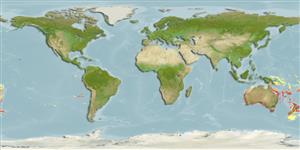>
Gadiformes (Cods) >
Moridae (Morid cods)
Etymology: Physiculus: Diminutive of Greek, physa = tube.
Issue
The gender agreement of the specific epithet needs clarification. Kept as the original name luminosa in Eschmeyer (CofF ver. May 2011: Ref. 86870).
Environment: milieu / climate zone / depth range / distribution range
Écologie
marin bathydémersal; profondeur 130 - 640 m (Ref. 31777). Deep-water
South Pacific: off South America on the Nasca (Nazca) Ridge, Austral Ridge in central South Pacific, and southwestern Pacific off northern New Zealand and eastern Australia (Queensland and New South Wales). Reported from off New Caledonia.
Taille / Poids / Âge
Maturity: Lm ? range ? - ? cm
Max length : 30.0 cm TL mâle / non sexé; (Ref. 9563)
A temperate (Ref. 7300) and benthic species (Ref. 75154) recorded from the upper continental slope (Ref. 9563, 75154).
Life cycle and mating behavior
Maturities | Reproduction | Spawnings | Egg(s) | Fecundities | Larves
May, J.L. and J.G.H. Maxwell, 1986. Trawl fish from temperate waters of Australia. CSIRO Division of Fisheries Research, Tasmania. 492 p. (Ref. 9563)
Statut dans la liste rouge de l'IUCN (Ref. 130435)
Menace pour l'homme
Harmless
Utilisations par l'homme
Outils
Articles particuliers
Télécharger en XML
Sources Internet
Estimates based on models
Preferred temperature (Ref.
123201): 11.2 - 18.8, mean 13 °C (based on 55 cells).
Phylogenetic diversity index (Ref.
82804): PD
50 = 0.5000 [Uniqueness, from 0.5 = low to 2.0 = high].
Bayesian length-weight: a=0.00389 (0.00195 - 0.00776), b=3.11 (2.93 - 3.29), in cm total length, based on LWR estimates for this (Sub)family-body shape (Ref.
93245).
Niveau trophique (Ref.
69278): 3.4 ±0.4 se; based on size and trophs of closest relatives
Résilience (Ref.
120179): Milieu, temps minimum de doublement de population : 1,4 à 4,4 années (Assuming tmax>3).
Fishing Vulnerability (Ref.
59153): Low vulnerability (20 of 100).
